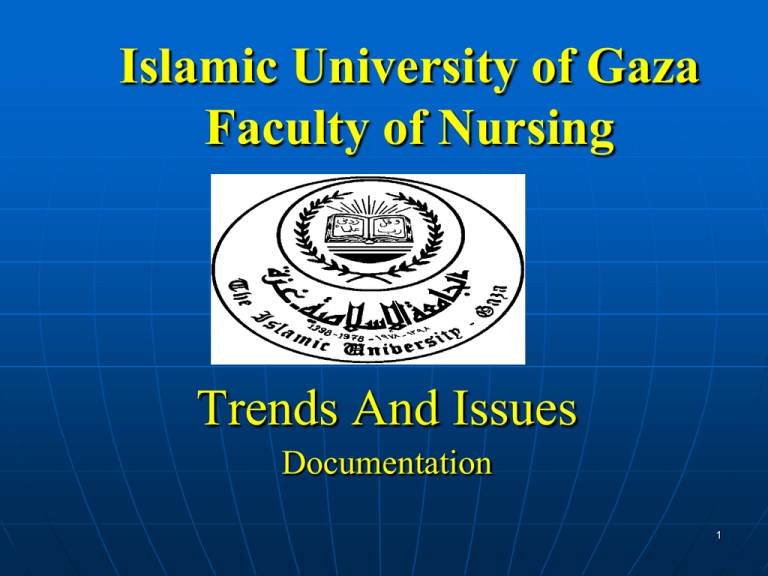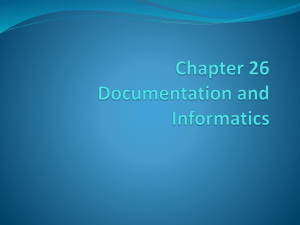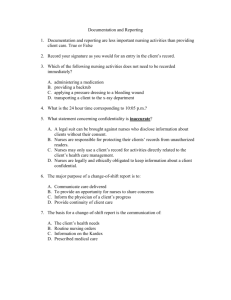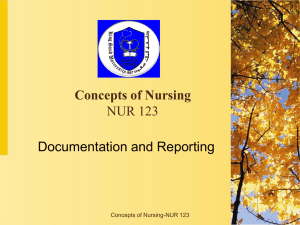A nurse's documentation
advertisement

Islamic University of Gaza Faculty of Nursing Trends And Issues Documentation 1 Introduction Documentation in the health record is an integral part of safe and effective nursing practice. Clear, comprehensive and accurate documentation is a judgment and critical thinking used in professional practice and provides an account of nursing’s unique contribution to health care. Effective communication requires to be done in a timely manner. 2 Nurses should also be aware of the legislative requirements regarding documentation that may apply to their particular practice setting. Effective documentation policies and practice take into consideration who the clients are, client needs and available resources. 3 Purpose of Documentation 1. Communication Documentation is fundamentally communication that reflects the client’s perspective on his/her health, the care provided, the effect of care and the continuity of care. Effective documentation assists clients to make future care decisions. Accurate documentation also reflects the effectiveness of the care provided. Accurate documentation provides a reliable, permanent record of client information. 4 2. Accountability The health record demonstrates nurses’ accountability and gives credit to nurses for their professional practice. It is used to determine responsibility and may be used in legal proceedings. Legislative issues: failing to keep records as required, falsifying a record, signing or issuing a false or misleading statement, giving information about a client without consent and storage and retrieval of documentation. 5 3. Quality improvement Information from the health record is often used to evaluate professional practice during quality improvement processes, such as performance reviews, accreditation, legislated inspections and board reviews ()األمناء. Clear documentation facilitates the evaluation of the client’s progress toward desired outcomes. It enables nurses to identify and address areas that need improvement. Poor documentation provides incomplete or no written evidence of the quality of care provided. 6 4. Research Health records can be a valuable source of data for health research. Health records can be used to assess nursing interventions and evaluate client outcomes, as well as to identify care issues. Accurately recorded information is essential to provide accurate research data. Through research, nurses can improve nursing practice. 7 5. Funding and resource management Data from health records can identify the type and amount of care that clients need, the care and services provided, and the effectiveness of that care. Any of these factors may affect funding and resource allocation. Workload or client classification systems are best derived as byproducts of client documentation. 8 Core Standards for Documentation These are the minimum expectations: nurse maintains documentation that is: Clear, concise and comprehensive Accurate, true and honest; Relevant; Reflective of observations, not of unfounded conclusions Timely and completed only during or after giving care Chronological: present a clear picture of events 9 Complete record of nursing care provided, including assessments, identification of health issues, a plan of care, implementation and evaluation Legible and non-erasable Permanent Retrievable Confidential; Client-focused; Using forms, methods, systems provided 10 A nurse’s documentation: Includes date and time of the care; Identifies who provided the care; Avoids meaningless phrases such as “good ” “bad or “OK”; Includes what was observed and avoids statements such as “appears to” and “seems to” when describing observations; Includes signatures or initials; Avoids duplication of information Forgotten or late entries, errors and omissions, (written with Date, time, and signature) 11 Documentation forms Effective documentation forms provide a framework and guide documentation. To remain effective, forms often require regular review and revision. This review process takes into account beliefs and values about health and organizational policy, as well as external factors such as legislation. For example, a facility that values client perception of his/her health as an important aspect of a complete assessment will have a form that includes space for this information. 12 Kardexes Kardexes are a communication tool used to convey the client’s current orders as well as upcoming tests or surgery, diet, etc quickly and briefly. Nurses use it to organize the care and to manage time and multiple priorities. Kardexes may be in paper or electronic format. The information they contain may be erasable. Updating Kardex information regularly Ensuring that temporary worksheets are shredded when no longer in use ensuring that relevant information on a Kardex is captured in the permanent health record 13 Care Plans Care plans are written outlines of care for individual clients. They are part of the permanent health record. Effective care plans are up-to-date and clearly identify the needs and wishes of the client. Individualizing care plans to meet the needs and wishes of individual clients 14 Monitoring strips All relevant assessment data needs to be retained in the health record, including monitoring strips, such as cardiac, fetal, thermal or blood pressure testing. Documenting on the monitoring strip the client’s name and/or identification code, and the date and time. Advocating to have strips retained as part of the permanent record 15 Documentation content Assessment Documenting the assessment of a client includes recording the subjective and objective data. Objective data can be observed (e.g., swelling, bleeding, crying) or measured (e.g., heart rate, blood pressure, temperature) Subjective data such as statements or feedback from the client Subjective data are clearly identified as such by using quotation marks or other marks to distinguish it from objective data. 16 Third–party information Nurses may obtain relevant information about a client or an incident from another person, such as the client’s family member (e.g., the mother of a pediatric client) or friend. 17 Documentation methods Some agencies may combine elements of different documentation methods and formats to document care effectively. Regardless of the method, the health record must present a clear picture of the nurse’s assessment, actions and outcomes. Common methods include charting by exception, focus charting, SOAP/ SOAPIER and narrative documentation. May be Paper or Paperless (Electronic health records) 18 Do's and Don'ts of Nursing Documentation Do's Check that you have the correct file before you begin writing. Make sure your documentation reflects the nursing process. Write legibly. Chart the time you gave a medication, the administration route, and the patient's response. Chart precautions or preventive measures used, such as bed rails. Record each phone call to a physician, including the exact time, message, and response. 19 Do's….. Chart patient care at the time you provide it. If you remember an important point after you've completed your documentation, chart the information with a notation that it's a "late entry." Include the date and time of the late entry. Document often enough to tell the whole story. 20 Don'ts Don't chart a symptom, such as "c/o pain," without also charting what you did about it. Don't alter a patient's record - this is a criminal offense. Don't use shorthand or abbreviations that aren't widely accepted. Don't write imprecise descriptions, such as "a large amount." 21 Don't Don't chart what someone else said, heard, felt, or smelled unless the information is critical. In that case, use quotations and attribute the remarks appropriately. Don't chart care ahead of time - something may happen and you may be unable to actually give the care you've charted. Charting care that you haven't done is considered fraud (deception )الغش. Thank you……………….. 22






